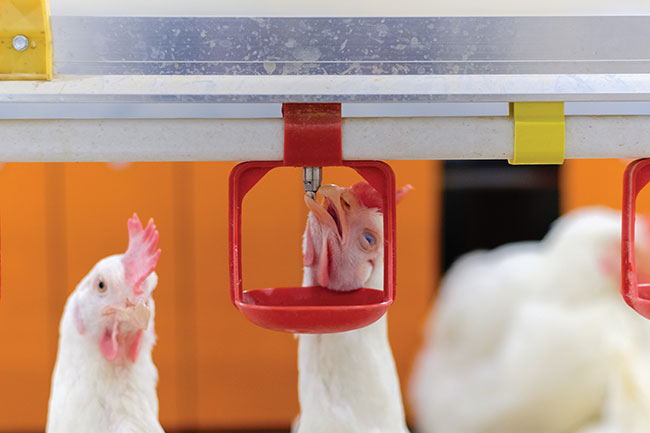
Avian influenza and your water
By Mary K. Foy
Features Barn Management avian influenza H5N1 water managementOnce inside the water line, a virus can survive for weeks.
 Water management is especially important with the H5N1 subtype the North American industry is facing this year. PHOTO CREDIT: Big Dutchman
Water management is especially important with the H5N1 subtype the North American industry is facing this year. PHOTO CREDIT: Big Dutchman The dreaded headlines are back. We have all been put on high alert for avian influenza – again. Many of us remember the 2015 outbreak where we were all reminded and/or taught what to do, and not do when highly pathogenic avian influenza virus (HPAIV) is detected in our area or even in our own flock.
Every meeting had the “biosecurity talk” the “notification talk” the “cleaning and disinfecting talk” – all valuable points of discussion and information. We did not see much of the inclusion of the water system in these discussions at that time. I’m not talking about the water source – pulling from surface water is a huge no-no when you have migratory birds infected with HPAIV in a flyway over your farm – I’m talking about the water system in your barn.
My company was asked to be a consultant for a grower that had been hit by avian influenza at that time. They were wanting to make sure they had done all they could before placing birds again even though they had been cleared for placement and were just waiting out the days they had to be on “hold”.
Before we were involved, a contracted, trained cleaning crew had come into the barns to do the final cleaning and disinfecting. This group had submitted their plan to the appropriate government entity and it had been approved. The working crew was well trained in biosecurity issues. They wore biohazard suits and cleaned everything in the barn beginning with the removal of organics, then wash-down with a cleaning agent and, in the final steps, they sprayed everything from the ceiling to the baseboards with a disinfectant.
Government officials had to approve the process and were involved in the concluding inspection. When all was said and done the grower was presented a list for his records of all that had been cleaned and disinfected. Two pages of single line items had been cleaned, removed, and/or disinfected. Guess what was not on that list? The inside of the water line.
This becomes an especially important point with the H5N1 subtype we are facing again this year. Different subtypes of viruses have different types of shedding patterns. For example, the H9N2 subtype typically can be detected in fecal droppings or cloacal swabs but is not often detected when only tracheal swabs are done.
The opposite is true of the H5N1 subtype. Because this virus survives well in the trachea there is a higher possibility that it will be found in the drinking water. Keep in mind that the water system is not a closed system. Every time a bird triggers a drinker, they open the system – and they leave whatever was on their beak on the drinker. Anything that is in that barn, be it a mold spore or a bacterium or a virus, can wind up inside the water line. Once inside the water line, a virus can survive for days or weeks.
The ability of that virus to survive will also depend on available water treatment. If the water lines are full of organic build-up, any treatment added to the water is going to be quickly bound to those organics and ineffective against a virus that may now be buried under a few layers of buildup in the water line. The cleaner the water lines, the more effectively your water treatment can help you fight what gets introduced into the water lines by the birds or the opening of the nipple drinkers during the flock.
Recent reviews of how the 2015 outbreak was handled have led to the emphasis of some steps that may have been missed then. One of those steps is water line cleaning. In a May 2018 article of “Ask the Vet” in Canadian Poultry, Tom Inglis includes water line cleaning in the steps of recovering from an HPAIV event. Several poultry sites also now include water line cleaning in their biosecurity suggestions or in the cleaning/disinfection guidelines for a poultry facility that has had an HPAIV event.
Don’t forget the water system when the discussion turns to biosecurity, keeping the barn clean, or recovery from a disease event. It could be the one place that is harboring the enemy.
For references, view the online version of this article at canadianpoultrymag.com.
Mary K. Foy is the director of technical services for Proxy-Clean Products. The U.S. company’s cleaning solution is used in Canada as part of the Water Smart Program developed by Weeden Environments and Jefo Inc.
Print this page